Transducers are devices which convert energy from one form to other. A microphone is a transducer which converts sound energy to electrical signals. It works opposite to a speaker (see how speaker works). Microphones are available in different shape and sizes. Depending on the application, a microphone may use different technologies to convert sound to electrical signals. Here we are going to discuss about the Electret Condenser Microphone which is widely used in mobile phones, laptops, etc.
Electret Condenser Microphone, as the name suggests is a parallel plate capacitor and works on the principle of a variable capacitance. It consists of two plates, one fixed (called the back plate) and the other moveable (called Diaphragm) with a small gap between them. An electric potential charges the plate. When sound strikes the diaphragm it starts moving, thereby changing the capacitance between the plates which in turn results in a variable electric current to flow.
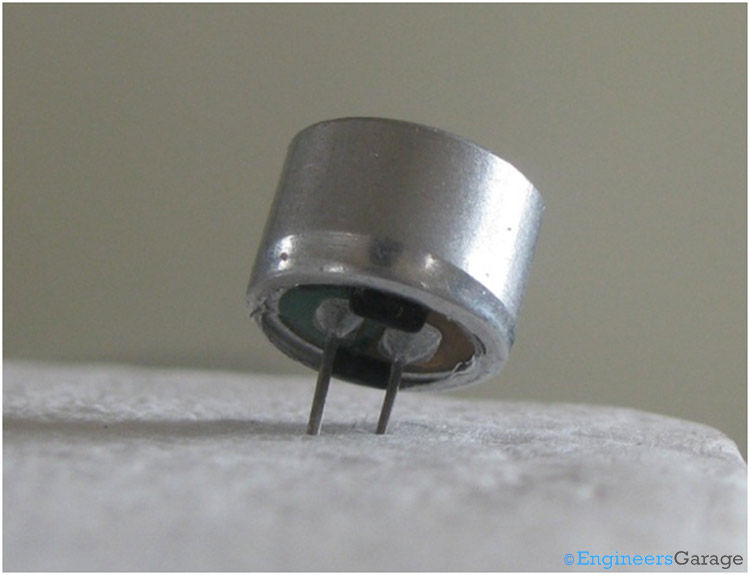
Fig. 1: Image of Electret Microphone and Two Legs
The above image shows an Electret microphone. These microphones are widely used in electronic circuits to detect minor sounds or air vibrations which in turn are converted to electrical signals for further use. The two legs as shown in the image above are used to make electrical connection with the circuit.
Porous Covering

Fig. 2: Porous Material Covering the Top Face
A solid conducting metal body encapsulates the various parts of the microphone. The top face is covered with a porous material with the help of glue. It acts as a filter for the dust particles. The sound signals/air vibrations passes through the porous material and falls on the diaphragm through the hole shown in the image above.
Top View

Fig. 3: Top View—Diaphragm
The diaphragm through the hole can be seen in the image above.

Fig. 4: “Capsule” of Microphone—Image Showing the Cylindrical Plastic Inside Metal Body
On removing the metal body, a cylindrical plastic covering can be seen which provides the mechanical strength and supports the entire assembly. This entire assembly is called the capsule.
Capacitor Plates
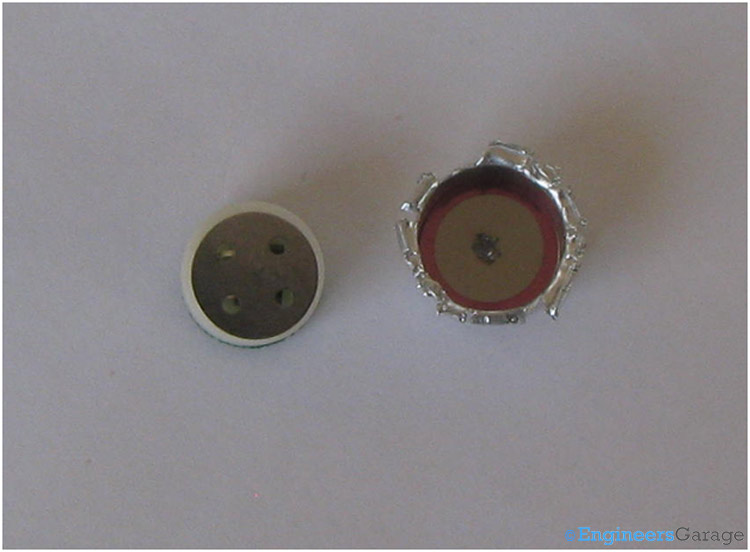
Fig. 5: Two Plates of Capacitor
The two plates of the capacitor, which is the heart of the condenser microphone is shown in the image above. The diaphragm (inside the metal body) is a very thin film of conducting metal. It is deformable and elastic in nature. The diaphragm is pasted on a solid hollow ring which provides the necessary support to the diaphragm. The back plate is a thick solid perforated metallic plate. It is coated with a permanently charged electret material to eliminate the need of polarized power supply. These electrets are made by melting a dielectric material (like wax, plastic, etc) that contains polar molecules and solidifying them back in a strong electrostatic field. The polar molecules of the dielectric material are inclined towards the direction of electrostatic field and create a permanent electrostatic bias in them. In the modern microphones, PTFE (Poly Tetra Fluoro Ethylene) plastic is used to form the electric material.
The design of the holes plays a very vital role in reducing the air damping and mechanical thermal noise. The two plates have a small gap between them to allow the movements of diaphragm. A very fine thin film of plastic is placed between the two plates to provide electrical insulation. The diaphragm moves in the air gap between the plates with the slightest disturbance caused in the surrounding air pressure by the sound signal.
Diaphragm & Spacer
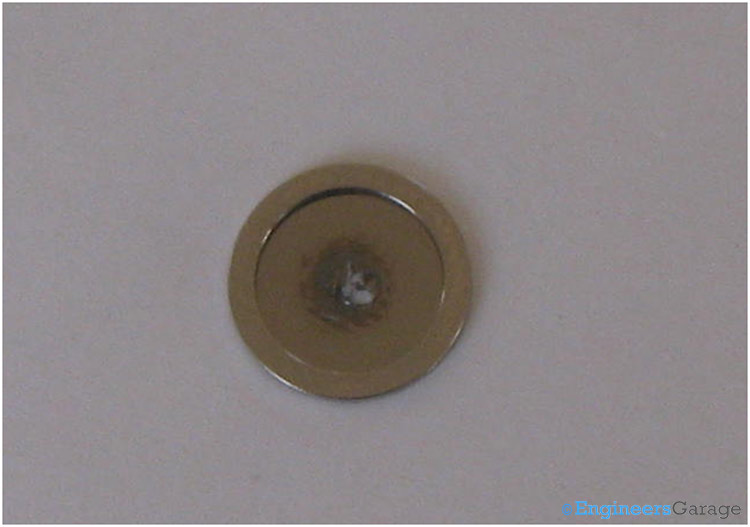
Fig. 6: Hollow Ring of Diaphragm
The solid hollow ring of the diaphragm is used to connect the diaphragm with the outer metal covering.
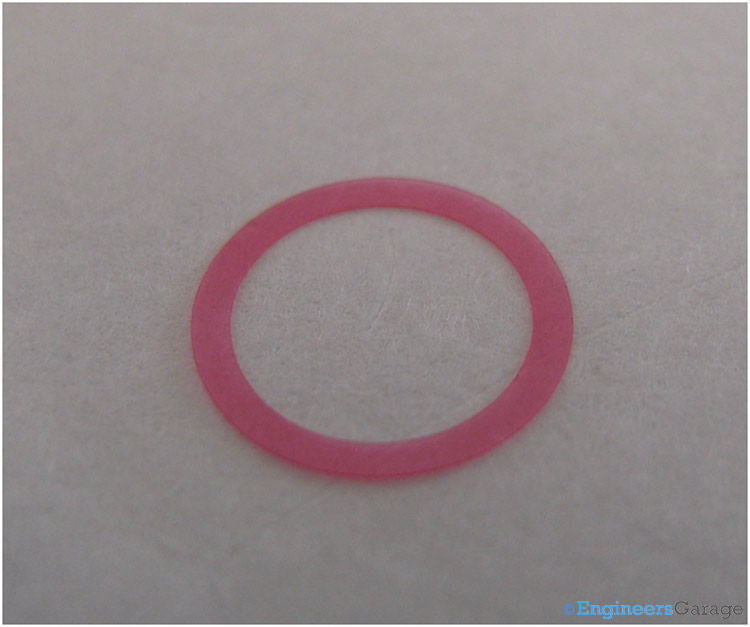
Fig. 7: Plastic Spacer Placed Between two Plates
A very thin plastic spacer is placed between both the plates to insulate them as well as provide the gap to move the diaphragm
Electrical Connection &JFET
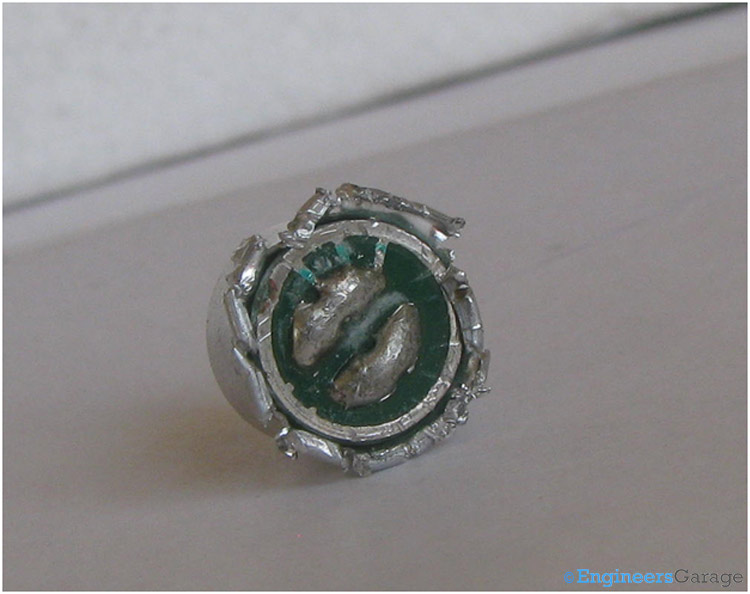
Fig. 8: Metallic Covering of Diaphragm
The diaphragm is electrically connected to one of the legs of the microphone via the outermost metallic covering.
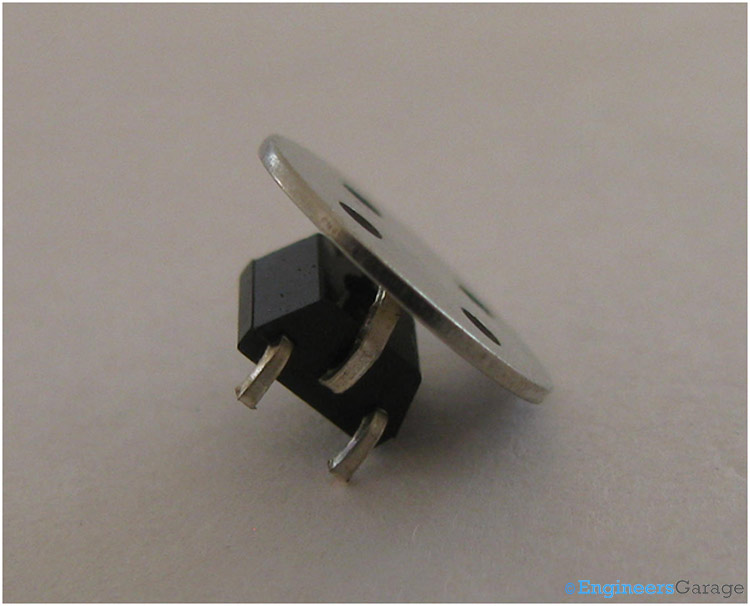
Fig. 9: Junction Field Effect Transistor
A JFET (Junction Field Effect Transitor) transistor is used to amplify the electrical current generated. The back plate, fixed in the capsule, is connected with the gate of the transistor, source is connected with the ground of the external circuit and electrical signal appears on the drain.
Working:
Sound creates vibrations in surrounding air particles. When a sound is produced near the microphone, vibrating air particles strikes the diaphragm. The resultant air pressure moves diaphragm changing the distance between the plates. The electret material pasted on the back plate, maintains a constant static charge across the capacitor. Relation between the voltage, charge & capacitance is formulated as V=Q/C.
Capacitance of a capacitor depends on the distance between its plates. When the air pressure makes the diaphragm move back and forth, capacitance varies accordingly and thus voltage varies too. This varying voltage produces a variable electric current which is in accordance with the sound vibrations at the diaphragm.
Filed Under: Insight


Questions related to this article?
👉Ask and discuss on Electro-Tech-Online.com and EDAboard.com forums.
Tell Us What You Think!!
You must be logged in to post a comment.